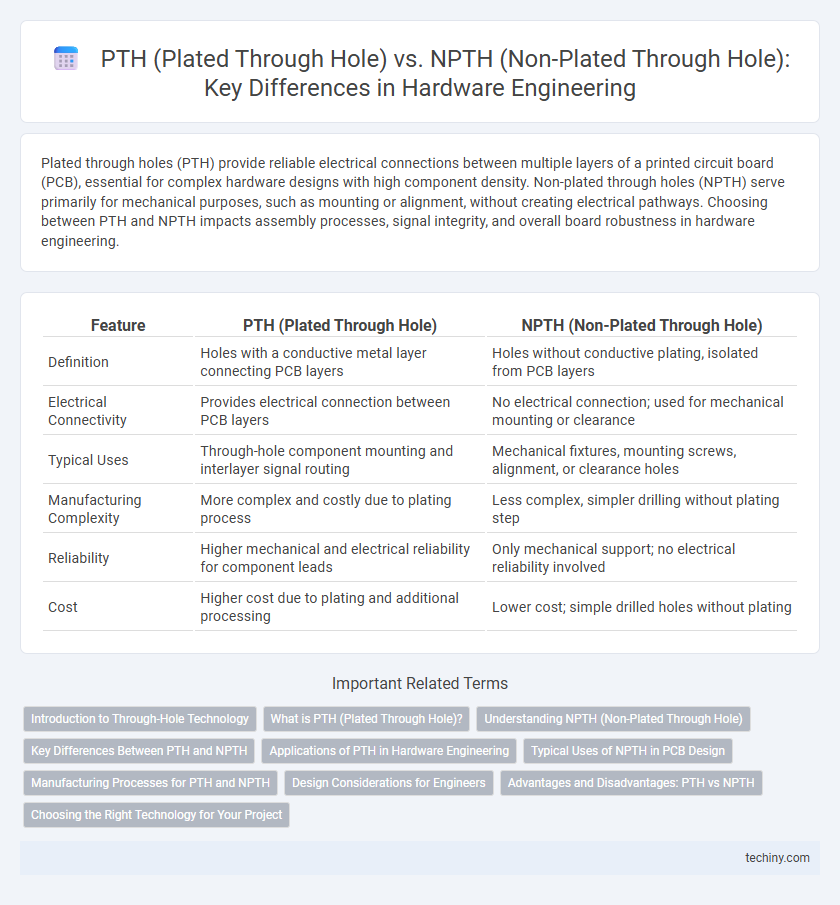Plated through holes (PTH) provide reliable electrical connections between multiple layers of a printed circuit board (PCB), essential for complex hardware designs with high component density. Non-plated through holes (NPTH) serve primarily for mechanical purposes, such as mounting or alignment, without creating electrical pathways. Choosing between PTH and NPTH impacts assembly processes, signal integrity, and overall board robustness in hardware engineering.
Table of Comparison
| Feature | PTH (Plated Through Hole) | NPTH (Non-Plated Through Hole) |
|---|---|---|
| Definition | Holes with a conductive metal layer connecting PCB layers | Holes without conductive plating, isolated from PCB layers |
| Electrical Connectivity | Provides electrical connection between PCB layers | No electrical connection; used for mechanical mounting or clearance |
| Typical Uses | Through-hole component mounting and interlayer signal routing | Mechanical fixtures, mounting screws, alignment, or clearance holes |
| Manufacturing Complexity | More complex and costly due to plating process | Less complex, simpler drilling without plating step |
| Reliability | Higher mechanical and electrical reliability for component leads | Only mechanical support; no electrical reliability involved |
| Cost | Higher cost due to plating and additional processing | Lower cost; simple drilled holes without plating |
Introduction to Through-Hole Technology
Through-hole technology (THT) involves inserting component leads into drilled holes on a printed circuit board (PCB), with plated through holes (PTH) providing conductive copper plating on the hole walls to ensure electrical connectivity between PCB layers. Non-plated through holes (NPTH) serve primarily as mechanical mounting points or alignment guides without electrical conduction. The choice between PTH and NPTH depends on the functional requirements of the PCB design, where PTH supports soldering and inter-layer connections, while NPTH facilitates structural support or component placement.
What is PTH (Plated Through Hole)?
PTH (Plated Through Hole) is a type of hole in printed circuit boards (PCBs) where the interior surface is coated with a conductive metal layer, allowing electrical connectivity between different layers of the PCB. PTH is essential for mounting components with leads that pass through the board, providing mechanical strength and reliable electrical connections. This technology contrasts with NPTH (Non-Plated Through Hole), which lacks the conductive plating and is typically used for mechanical support or alignment purposes only.
Understanding NPTH (Non-Plated Through Hole)
NPTH (Non-Plated Through Hole) refers to drilled holes in printed circuit boards (PCBs) that lack a conductive plating layer on the wall, which prevents electrical connectivity between layers. These holes are primarily used for mechanical mounting or clearance purposes rather than signal transmission or electrical connections. Understanding NPTH is crucial for designing PCB layouts that require component leads to pass through without establishing electrical contact across layers.
Key Differences Between PTH and NPTH
Plated through holes (PTH) are metallic-coated holes in printed circuit boards (PCBs) that provide electrical connections between different layers, enabling robust signal and power transmission. Non-plated through holes (NPTH) lack this metallic coating and serve purely mechanical purposes such as mounting or alignment without electrical conduction. Key differences include PTH's role in electrical connectivity and increased reliability versus NPTH's function for structural support and isolation.
Applications of PTH in Hardware Engineering
Plated Through Holes (PTH) are essential in hardware engineering for establishing reliable electrical connections between multiple layers of a printed circuit board (PCB), facilitating complex multi-layer designs. PTHs enhance mechanical strength and signal integrity in high-density interconnects, making them ideal for applications such as microprocessor boards and power electronics. Their conductive plating supports automated soldering processes, improving manufacturing efficiency in mass production of electronic devices.
Typical Uses of NPTH in PCB Design
Non-Plated Through Holes (NPTH) in PCB design are typically used for mechanical mounting, allowing screws or fasteners to secure components without electrical connectivity. NPTHs serve as alignment guides during PCB assembly and help reduce the risk of electrical shorts by isolating mounting points from conductive paths. These holes enhance structural integrity without interfering with signal integrity or layer interconnections essential for plated through holes (PTH).
Manufacturing Processes for PTH and NPTH
Plated Through Holes (PTH) undergo a process where holes are drilled and then copper plating is applied to create electrical connections between layers in a PCB, involving electroplating and thorough surface preparation. Non-Plated Through Holes (NPTH) are drilled without copper plating, primarily serving as mechanical mounting points or clearance holes, requiring less complex manufacturing steps but precise drilling for dimensional accuracy. The PTH process is critical for multi-layer board functionality, while NPTH focuses on structural integrity and component compatibility.
Design Considerations for Engineers
Designing with plated through holes (PTH) ensures reliable electrical connectivity across multiple PCB layers, which is crucial for complex circuit integration and signal integrity. Non-plated through holes (NPTH) serve primarily mechanical purposes such as mounting or alignment, requiring precise dimensioning to accommodate hardware without compromising board integrity. Engineers must balance factors like thermal expansion, manufacturability, and cost while selecting PTH or NPTH to optimize performance and meet assembly requirements.
Advantages and Disadvantages: PTH vs NPTH
Plated Through Holes (PTH) offer superior electrical conductivity and mechanical strength by creating a conductive path through the PCB layers, enabling reliable component mounting and signal integrity. Non-Plated Through Holes (NPTH) lack this conductive coating, making them ideal for mechanical fastening but unsuitable for electrical connections, often reducing signal reliability if used incorrectly. PTH increases manufacturing complexity and cost due to plating processes, whereas NPTH simplifies fabrication but limits design flexibility and durability in electrically demanding applications.
Choosing the Right Technology for Your Project
Selecting between Plated Through Hole (PTH) and Non-Plated Through Hole (NPTH) depends on the electrical connectivity and mechanical strength requirements of your hardware design. PTH is ideal for components requiring robust solder joints and reliable electrical connections, commonly used in multilayer PCBs for signal integrity and durability. NPTH is suited for mounting hardware or mechanical fixtures without electrical connection, offering cost-effective solutions where plating is unnecessary.
PTH (plated through hole) vs NPTH (non-plated through hole) Infographic

 techiny.com
techiny.com